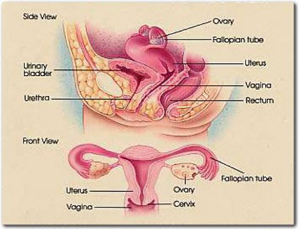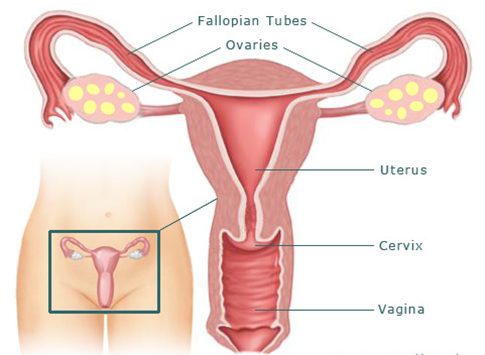
Fallopian tube recanalization removes fallopian tube blockage using special catheters. Fallopian tube blockage (tubal factor infertility) is one of the most common causes of female infertility. The fallopian tubes are very fine tube-like structures that connect the ovaries to the uterus. The eggs from the ovary normally travel through the fallopian tubes, where they can be met and fertilized by sperm. Sometimes the tubes can become blocked or narrowed, preventing pregnancy. This can happen in one or both fallopian tubes.
Interventional radiologists can diagnose and treat blocked fallopian tubes with a nonsurgical procedure known as selective salpingography. In the procedure, a contrast agent, or dye, is injected through a catheter into the uterus so an X-ray image of the uterine cavity can be obtained. When a fallopian tube blockage is identified, another catheter is threaded into the fallopian tube to open the blockage.
The fallopian tubes are important for female fertility. They are the passageways for the eggs to travel from the ovaries to the uterus. During conception:
What Causes Tubal Blockage?
 The most common cause of tubal factor infertility is pelvic inflammatory disease (PID). PID is a general term used to describe inflammation of the uterus, fallopian tubes and sometimes the ovaries. It is generally caused by repeated sexually transmitted infections (STIs) such as chlamydia or gonorrhea (although this is not always the case). If left untreated, scar tissue can build up, leading to the blockage of one or both fallopian tubes and infertility. If only one tube is blocked, you may still be able to conceive naturally depending on the health of the ovary on that side.
The most common cause of tubal factor infertility is pelvic inflammatory disease (PID). PID is a general term used to describe inflammation of the uterus, fallopian tubes and sometimes the ovaries. It is generally caused by repeated sexually transmitted infections (STIs) such as chlamydia or gonorrhea (although this is not always the case). If left untreated, scar tissue can build up, leading to the blockage of one or both fallopian tubes and infertility. If only one tube is blocked, you may still be able to conceive naturally depending on the health of the ovary on that side.
Other causes of tubal factor infertility include endometriosis, previous ectopic pregnancy, previous abdominal surgery, history of infection caused by miscarriage or abortion, and previous or current infection with gonorrhea or chlamydia. Although tuberculosis is relatively rare in the Western world, it can also cause infection in the fallopian tubes, as can a ruptured appendix. All of these can cause scar tissue, mucus and debris to build up in the fallopian tubes, which can lead to blockage.
What to Expect
Prior to appointments, Gwinnett Medical Center patients are asked to come in for routine lab work. It is preferred that patients have their lab work performed at Gwinnett Medical Center so the radiology nurses have access to the results. Our radiology nurses call each patient shortly after the procedure is scheduled to obtain a health history and provide instructions.
For most interventional radiology exams, patients need to arrive in admissions two hours before their scheduled procedure time on the day of the exam. Patients will check in at admissions before being taken to the Imaging Nursing Unit, where an interventional radiologist will come to talk with the patient before the procedure. The patient will then be prepped for the exam and taken to the Interventional Radiology Suite for the procedure. Following the procedure, the patient will return to the Imaging Nursing Unit for recovery. The recovery time varies based on the procedure. After the patient is then discharged, he or she will receive a follow-up call the next day.

Dr. Vikas Chhabra is Specialist in General Surgery & have 22 Yrs Experience in General, Laproscopic, Endourology, Plastic & Laser Surgeries.

Dr. Kiran Chhabra is famous Consultant of IVF, She is Specialist in Gynaecology & practicing Gynae, Obs & Infertility since 2003.

Dr. Aman Chhabra is famous Orthopedic Surgeon, He is Specialist in Ortho, Hand Surgery & Joint Replacement and have more than 15 Yrs Experience.
View More
Test Tube Baby Centre
Operation Theatre
Ventilator
ICU
OPD
Ultrasound
Colour Doppler
Laboratory
Patient Rooms
Pharmacy
24 Hours Service
Chhabra Hospital &
Test Tube Baby Centre
Near Stadium,
80 Feet Road,
Bathinda (Punjab)
Pin: 151001